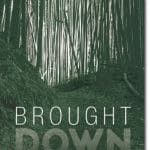Much pleasure awaits the reader of Blue Portugal, Theresa Kishkan’s collection of ten essays that sing individually and re-engage with each other throughout the volume. It is not simply a matter of rebounding colours among “The Blue Etymologies,” “Blue Portugal,” and “Blueprints,” nor the recurrence of journeys dark and light; rather, Kishkan’s poetic phrasing and rhythms thread these braided essays with originality of perception, reflection, and a lyric sensibility.
Each essay begins with a design of overlapping circles, a Venn diagram that captures the structure of the book – a braiding within and among each essay as the author creates a kind of fugue structure. Her epigraph from Odyssey introduces a note of darkness, picked up in the first essay, “A Dark Path,” which in turn quotes from Dante’s Inferno for its epigraph. From Dante’s “hidden tunnel” and path she turns to her own domestic scene of evening reading with her husband and fellow poet, John Pass. Her refrain, “What are you afraid of?” courses through the essay, mingling with a pair of coyotes circling each other outside. Circling coyotes enter the frame of her Venn diagram, in preparation for her own sewing and patchwork quilting – a careful collage of text and textures. She is careful of her footing because she had fallen on an icy sidewalk and fractured her coccyx: “the impact resulted in a torn retina and dull pain encircling my pelvic girdle.” Circling coyotes and encircling pelvic girdle join in the uncertain paths that follow.
Essayistic streams of consciousness fuse the author’s fractured pelvis with her dead dog’s pelvis, kept as a memento on her desk. The uncertain path diverges from pelvis to patchwork – deep blue linen scraps. “These are my years, scraps of my years, cut into squares and small rectangles, arranged as a series of cobbles for the mind to step along, carefully, one after another.” What Kishkan cobbles together is a shared symmetry, boldly unfolding, until by the end of “A Dark Path” she is no longer afraid, braided with her reader.
Her colourful tapestry continues in the second essay, “The Blue Etymologies,” which begins with Isaac Newton seeing a rainbow through a prism. Poet-essayist explores the roots and routes of words, history, migration, patterns that span Newton’s rainbow. Newton translated the seven colours into the seven notes on a musical scale, a correlation that enters the senses in these essays. The author moves to her personal visual experience of a torn retina that has to be lasered by an ophthalmologist. She experiences an “entoptic phenomenon” and parses the word “entoptic” from the Greek. The scientific world becomes poetic in her synoptic and synaptic associations down a rabbit hole of pigments to Picasso’s Blue Period. At the blue hour of twilight she drinks Modrý Portugal, the Blue Portugal of her title, a wine that is not Portuguese, but whose grapes may have actually migrated from Portugal to Eastern Europe. This grape makes its way and wine from the Iberian Peninsula to her Czech and Ukrainian roots.
Her streams of consciousness flow from Oliver Sacks’s “Luminous, numinous…. It was the color of heaven” to the discovery of caves in France 35,000 years ago. The cave drawings changed lives and left stories for those who came after. As she hangs her pigmented cloth on the line in the New World, her mind travels back to prehistory to correlate patterns and imagery from 25,000 years ago: “lattices, spirals, zigzag lines, filigrees, parallel lines.” These shapes enter her writing to form the structure of her entoptic essays that follow the spiral to the heart of mystery.
The next essay begins with a reference to Bach’s Violin Partita, which calls for dancing a minuet. Kishkan time travels across different countries and family memories. Her prose dances rhythmically: “A linear movement in binary form. Walk three steps, then lift a foot. 2/4 time.” At a cancer clinic in Vancouver, she remembers a bas-relief sculpture of the Venus of Laussel from the Paleolithic period. A sarabande takes her from the Beskydy Mountain to a porch in Edmonton: “Stately slow, the ancient transhumance of sheep and their shepherds, a migration.” Her essays are a vast migration on the most intimate terms and terrain — the counterpoint of the self, searching for ancestors everywhere.
“Blue Portugal” begins with drinking wine in Prague. She listens to the music of Janáček, as her train of thought accompanies her grandmother from the Czech Republic in 1913 to Antwerp, Saint John, and eventually Drumheller, Alberta. Landscapes are layered, borders always shifting, the steerage crossing unbearable, as are all the Ukrainian hardships long before the current war.
“How Rivers Break Away and Meet Again” starts with Virginia Woolf in a cold river. The rivers belong to the braiding pattern, the double helix of DNA, veins and vines, fugues, and bridges. Her essay ends with instruction: “Turn the page. This atlas continues. Here are the maps of your legs and feet, a dense braiding of veins and arteries, blue, red, the multiple small tributaries finding their way to your heart, and back.” Kishkan turns pages and corners, paying tribute to tributaries, lamenting and celebrating encyclopedically.
Her elegiac rhapsody in blue recurs in “Blueprint” where we follow the construction of her house in British Columbia. Her web of essays are palimpsests covering and uncovering hidden roots and rhizomes. From Dante to duende, and the melancholic saudade of fado, Blue Portugal cultivates grapes and vintages. Follow Kishkan closely along many paths of anatomy and destiny.
Theresa Kishkan lives on the Sechelt Peninsula in British Columbia. She has published more than a dozen books, including poetry, fiction, and collections of essays.
- Publisher : The University of Alberta Press (May 6 2022)
- Language : English
- Paperback : 208 pages
- ISBN-10 : 1772125997
- ISBN-13 : 978-1772125993
Michael Greenstein is a retired professor of English at the Université de Sherbrooke. He is the author of Third Solitudes: Tradition and Discontinuity in Jewish-Canadian Literature and has published widely on Victorian, Canadian, and American-Jewish literature.










